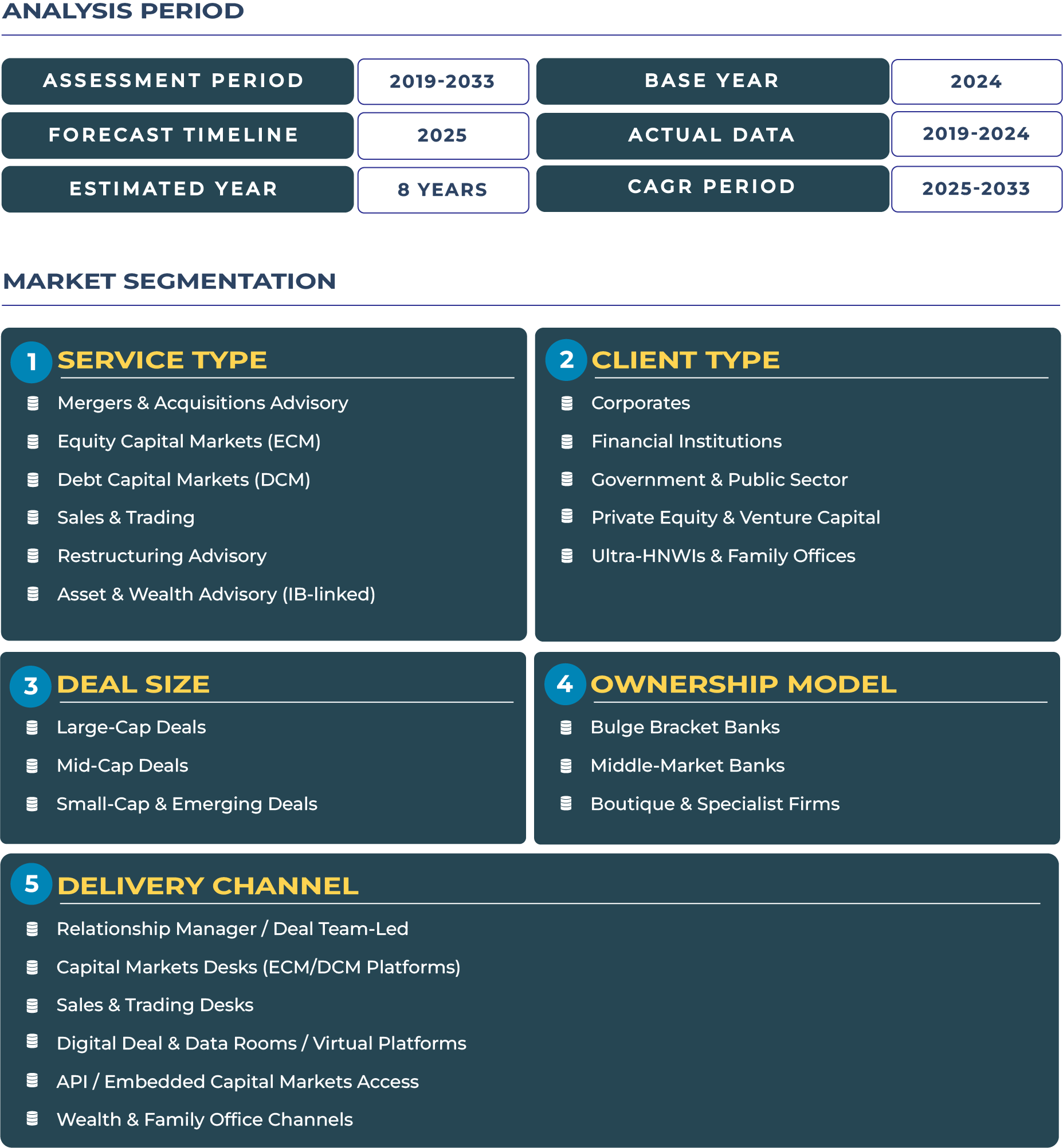Peru investment banking market Outlook: Driving Growth through Mining and Commodity-Linked Advisory Transformation
Peru, a mineral-rich economy at the heart of Latin America, is witnessing a strategic transformation in its investment banking market, driven by the dynamic mining and commodity-linked financing ecosystem. The nation’s economic backbone, anchored in copper, gold, and lithium exports, continues to attract institutional investors, multinational corporations, and private equity funds seeking exposure to infrastructure and natural resource assets. The growing emphasis on structured finance and mergers and acquisitions in the mining sector reflects how financial intermediaries are adapting to a more sophisticated investment landscape.
Note:* The market size refers to the total revenue generated by banks through various services.
According to DataCube Research, the Peru Investment Banking Market is valued at USD 1.4 billion in 2025 and projected to reach USD 1.9 billion by 2033, registering a CAGR of 3.9% from 2025 to 2033. This gradual yet stable growth trajectory highlights the expanding scope for Equity Capital Markets, Debt Capital Markets, and Restructuring Advisory services linked to the country’s mining and infrastructure domains. The continuous reforms by the Ministry of Economy and Finance (MEF) and capital market development efforts led by Superintendencia del Mercado de Valores (SMV) have reinforced investor confidence in Peru’s financial ecosystem.
Investment Banking Anchored in Mining and Commodity Advisory Expansion
The investment banking sector in Peru is strategically aligned with the country’s natural resource economy. With global demand for copper and lithium expected to surge, financial institutions are increasingly providing project finance and structured debt instruments for mining infrastructure expansion. Investment banks are also playing a pivotal role in facilitating cross-border acquisitions involving Latin American and Asian partners, given Peru’s strong trade relationships with China and Japan. Moreover, advisory services linked to sustainability financing and green mining investments are gaining prominence as Peru positions itself as a key player in the energy transition landscape.
While the local capital market remains relatively small compared to regional peers, progressive reforms aimed at boosting corporate bond issuance and enhancing liquidity in secondary markets are reshaping the financial sector’s growth potential. The Peruvian government’s focus on privatization of select infrastructure assets, particularly in transport and utilities, further enhances the pipeline of advisory and underwriting mandates available for domestic and global investment banks. As such, the market outlook remains positive, supported by regulatory modernization and diversification of funding sources.
Drivers and Restraints: Mining-Driven Financing vs. Domestic Scale Limitations
Driving Forces: Expanding Mining and Commodity Financing as Growth Catalysts
Peru investment banking industry is gaining momentum from mining-led economic expansion. Global energy transition dynamics are fueling capital flows into copper, silver, and lithium extraction projects, where debt syndication and capital raising activities are intensifying. Investment banks are structuring innovative funding instruments, including green bonds and commodity-backed notes, to facilitate capital formation. Additionally, regional consolidation and privatization of state-owned mining infrastructure create lucrative advisory opportunities. For instance, the Peruvian government’s ongoing evaluation of public-private partnerships (PPPs) in energy and logistics is generating new mandates for financial intermediaries. The integration of ESG-linked metrics into corporate financing structures is also amplifying investor interest from North America and Europe.
Restraints: Limited Domestic Market and Political Uncertainty Curtaining Expansion
Despite the encouraging fundamentals, Peru investment banking ecosystem faces challenges stemming from limited domestic capital depth and persistent political uncertainty. The country’s frequent changes in administration and fluctuating policy direction create uncertainty for long-term investments. Additionally, the relative scarcity of large institutional investors and low retail participation in capital markets restrict deal flow diversity. Currency volatility and inflationary pressures, amplified by global commodity price swings, have further complicated cross-border financing conditions. These structural issues underscore the importance of policy stability and financial inclusion to unlock sustained sectoral growth.
Trends and Opportunities: Cross-Border Advisory and SME-Focused Financial Innovation
Emerging Trends: Rising Regional Cross-Border Advisory and Capital Market Integration
A key trend reshaping Peru investment banking landscape is the rise of cross-border advisory mandates involving regional corporations in Chile, Colombia, and Brazil. The expansion of Latin American corporate networks is driving complex merger and acquisition transactions, where Peruvian banks are acting as facilitators in multi-jurisdictional deal structures. The growing participation of Asian institutional investors, particularly from Japan and South Korea, in mining and logistics sectors, is also strengthening Peru’s integration into global financial flows. Moreover, the digitization of trading platforms and adoption of fintech solutions are optimizing settlement efficiency, portfolio management, and institutional trading transparency across the country’s financial sector.
Key Opportunities: SME and Commodity Advisory Services as Future Growth Engines
The surge in small and medium-sized enterprises (SMEs) participating in the mining value chain is opening a new frontier for advisory services. Investment banks are developing tailored financing models for SMEs engaged in supply chain logistics, equipment leasing, and environmental remediation. The government’s initiatives to boost SME access to credit, facilitated by the Central Reserve Bank of Peru (BCRP), provide an added incentive for financial institutions to expand this segment. Furthermore, the growing demand for commodity-linked derivatives, risk management solutions, and sustainability-linked bonds presents untapped potential for future capital market innovation.
Competitive Landscape: Strategic Moves by Local and Global Investment Banks
Peru investment banking landscape is defined by a combination of domestic leaders and international entrants. Local institutions such as BBVA Peru and Credicorp Capital are expanding their advisory portfolios, focusing on mining, energy, and infrastructure transactions. International players are also re-engaging with the market, particularly those with regional operations in the Andean corridor. In recent years, banks have been strengthening specialized teams in asset and wealth advisory, capital market structuring, and debt refinancing to capture value from the country’s ongoing economic reforms. The strategic focus on SME financing and commodity advisory has positioned the sector for steady, sustainable growth despite external macroeconomic headwinds.







